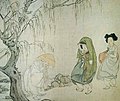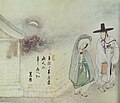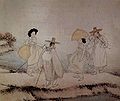Hanbok
Jump to navigation
Jump to search
Hanbok during the Three Kingdoms period
[edit]-
신라 King and queen's clothing during the Silla Kingdom period
-
고구려 Goguryeo Korea
-
고구려 Goguryeo Korea
-
앞치마를 두른 고구려인 Goguryeo Korea
-
고구려 주름치마 Goguryeo Korea
-
GAT / Goguryeo man with Gat, Gamshinchong tomb
-
고구려 Goguryeo people discussion, Korea
-
고구려 귀족 Goguryeo noble man, Korea
-
고구려 철갑 기병 Goguryeo irom armor horse warrior, Korea
-
고구려 달의 여신 Goguryeo Moon goddess, Korea
-
고구려 모자 쓴 남자 Goguryeo_Wearing a Hat like Gat, Gamshinchong tomb, Korea
-
신라 Silla
-
신라 Silla lady
-
신라금관 goldcrown
-
신라 Silla earrings
-
신라 벨트 Silla gold belt
-
신라 금관모 Silla unique gold crown hat
-
신라 last king of Silla 경순왕
-
신라 Silla Miruek- Buddha coming in the future or the next Buddha
-
신라 Silla Miruek- Buddha coming in the future or the next Buddha
-
가야 갑옷 Kaya armor
-
가야 갑옷 Kaya armor for a lady
-
가야 금관 Kaya gold crown
-
가야 Kaya Manuelshoi
-
백제 Baekje Toyong clay
-
백제 온조왕 Baekje King Onjo & Queen
-
백제 Baekje 5 ensemble
Hanbok of Goryeo Dynasty
[edit]-
Goryeo dynasty woman.
-
Copy of portrait of Jeong Mongju (1337∼1392). Redrawn in the 19th century.
-
Portrait of Lady Jo Ban (1341-1401).
-
Portrait of Yi Jehyeon, late Goryeo Dynasty.
-
10C Monk's hanbok
Hanbok of Joseon Dynasty
[edit]King
[edit]-
Gonryongpo (or ikseongwanpo): business attire for king
-
Hongryongpo: everyday clothes for king
-
Hwangryongpo: everyday clothes for king. Gojong began to wear the clothes.
-
Tongcheongwan (a hat) and Gangsapo
Queen
[edit]-
한국어: 황원삼English: Gold Wonsam
-
한국어: 당의English: Dangui
-
Dangui and seuranchima
-
Jeogui-Royal wedding ceremony
Gwanbok
[edit]Gwanbok (관복 官服) is a general term for business attire of government officers which are widely worn in three countries. We can see the same suits in Goguryeo Kingdom's tombs of 4~5century. And Baekje has a record they have announced public officers' attire's by colors and hats in 260, by the king Goi according to their ranks. Mosts of the records remain today are unified's Silla's. they started this in 520. It's a misconception that business attire started from Silla. There were several types of Gwanbok according to status, rank, and occasions.
-
Gwanbok in the Goryeo period, 11th century.
-
Gwanbok in the Goryeo period, 14th century.
-
Gwanbok in the 15th century
-
Gwanbok in the 17th century
-
Heuk dallyeongpo in the late 18th century
-
Geumgwan Jobok in the late 18th century
-
Sibok in the late 18th century
Day clothings for yangban during Joseon dynasty
[edit]Gentlmen
[edit]-
Hakchangui
-
Dopo
-
Dopo
-
Waryonggwan and hakchangui in 1863.
-
Bokgeon and simui in 1880.
-
Black bokgeon and blue dopo in 1880.
-
Photograph taken in 1863
-
Photograph taken in 1863
-
Yangban holding his ancestor's Wipae in 1895-1920
Noble women
[edit]-
한국어: 당의English: Dangui
Uniform
[edit]For Wedding
[edit]-
Hwalot
Commoners
[edit]Men's headgear
[edit]-
Joujeolpung
-
Chaek
-
Gat (from Goguryeo BC37-668)
-
Manoolshoi (Kaya)
-
Ikseongwan
-
Geumgwan
-
Tongcheongwan
-
Gat
-
Banggeon
-
Jeongjagwan on the head.
-
Tanggeon
-
Bokgeon
-
Jeonnip or called beonggeoji
Women's headgear
[edit]-
Gachae (wig)
-
Daesu
-
Jobawi
-
Ayam
-
Hwagwan
-
Jokduri
-
Gullae
-
Jangot
-
Sseugae chima
-
Satgat
-
Jeonmo
Shoes and socks
[edit]-
Kotshin or Hwahyejang
-
Korean Namakshin, Baekje
-
Wooden Namakshin, joseon
-
Jipshin or Mitooli (hemp shoes)
-
Jangwha, rubber rainboots
-
Gomooshin (rubber shoes)
-
Beoseon, Korean traditional socks
-
giant's gold gilt shoes, found in a tomb that have big person drawn in murals
























































































